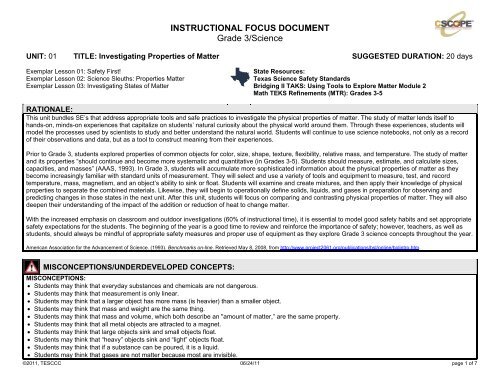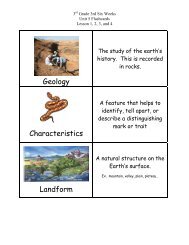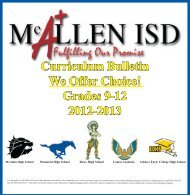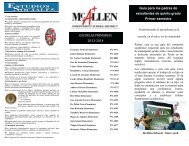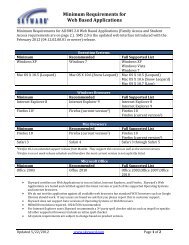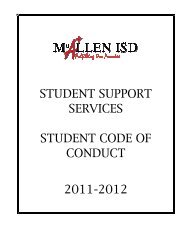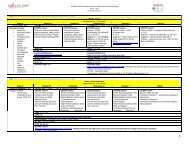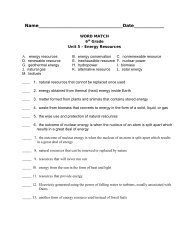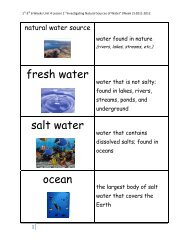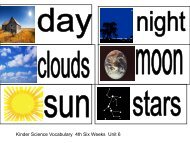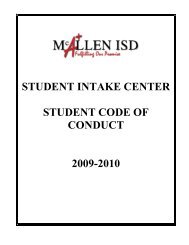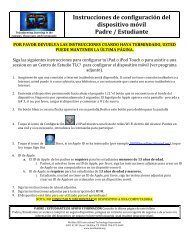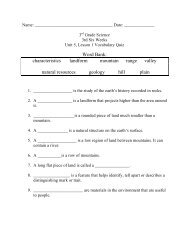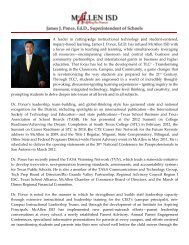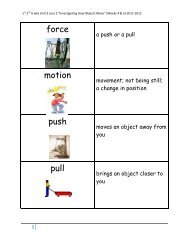3rd Grade Unit 01_IFD.pdf - McAllen ISD
3rd Grade Unit 01_IFD.pdf - McAllen ISD
3rd Grade Unit 01_IFD.pdf - McAllen ISD
Create successful ePaper yourself
Turn your PDF publications into a flip-book with our unique Google optimized e-Paper software.
INSTRUCTIONAL FOCUS DOCUMENT<strong>Grade</strong> 3/ScienceUNIT: <strong>01</strong> TITLE: Investigating Properties of Matter SUGGESTED DURATION: 20 daysTEKS#SE# TEKSclassroom and outdoor investigations, including observing a schoolyard habitat.3.2 Scientific investigation and reasoning. The student uses scientific inquiry methodsduring laboratory and outdoor investigations. The student is expected to:3.2B Collect data by observing and measuring using the metric systems and recognizedifferences between observed and measured data.3.2D Analyze and interpret patterns in data to construct reasonable explanations based onevidence from investigations.SPECIFICITYSAFE PRACTICESIncluding, but not limited to: Wearing safety goggles Washing hands Using materials appropriatelyCollectDESCRIPTIVE INVESTIGATIONSIncluding, but not limited to: Observing Measuring using the metric system Recognize differences between observed and measured dataAnalyze, InterpretPATTERNS IN DATAConstruct3.2E Demonstrate that repeated investigations may increase the reliability of results. DemonstrateREASONABLE EXPLANATIONS BASED ON EVIDENCEIncluding, but not limited to: Information from investigations Data from investigationsREPEATED INVESTIGATIONS3.2F Communicate valid conclusions supported by data in writing, by drawing pictures,and through verbal discussion.Including, but not limited to: May increase the reliability of resultsCommunicateVALID CONCLUSIONS SUPPORTED BY DATA3.3 Scientific investigation and reasoning. The student knows that information, criticalIncluding, but not limited to: In writing By drawing pictures Through verbal discussions©2<strong>01</strong>1, TESCCC 06/24/11 page 3 of 7
INSTRUCTIONAL FOCUS DOCUMENT<strong>Grade</strong> 3/ScienceUNIT: <strong>01</strong> TITLE: Investigating Properties of Matter SUGGESTED DURATION: 20 daysTEKS#SE# TEKSthinking, scientific problem solving, and the contributions of scientists are used inmaking decisions. The student is expected to:3.3A In all fields of science, analyze, evaluate, and critique scientific explanations by usingempirical evidence, logical reasoning, and experimental and observational testing,including examining all sides of scientific evidence of those scientific explanations,so as to encourage critical thinking by the student.3.3B Draw inferences and evaluate accuracy of product claims found in advertisementsand labels such as for toys and food.SPECIFICITYAnalyze, Evaluate, CritiqueSCIENTIFIC EXPLANATIONSIncluding, but not limited to: Empirical evidence Logical reasoning Experimental and observational testingDrawINFERENCES3.4 Scientific investigation and reasoning. The student knows how to use a variety oftools and methods to conduct science inquiry. The student is expected to:3.4A Collect, record, and analyze information using tools, including microscopes,cameras, computers, hand lenses, metric rulers, Celsius thermometers, wind vanes,rain gauges, pan balances, graduated cylinders, beakers, spring scales, hot plates,meter sticks, compasses, magnets, collecting nets, notebooks, sound recorders, andSun, Earth, and Moon system models; timing devices, including clocks and stopwatches; and materials to support observation of habitats of organisms such asterrariums and aquariums.3.4B Use safety equipment as appropriate, including safety goggles and gloves. Use©2<strong>01</strong>1, TESCCC 06/24/11 page 4 of 7EvaluateACCURACYIncluding, but not limited to: Product claims found in advertisements and labels Toys FoodCollect, Record, AnalyzeINFORMATION USING TOOLSIncluding, but not limited to: Microscopes Hand lenses Pan balances Graduated cylinders Beakers Magnets NotebooksSAFETY EQUIPMENTIncluding, but not limited to: Safety goggles Gloves
INSTRUCTIONAL FOCUS DOCUMENT<strong>Grade</strong> 3/ScienceUNIT: <strong>01</strong> TITLE: Investigating Properties of Matter SUGGESTED DURATION: 20 daysTEKS#SE# TEKS3.5 Matter and energy. The student knows that matter has measureable physicalproperties and those properties determine how matter is classified, changed, andused. The student is expected to:3.5A Measure, test, and record physical properties of matter, including temperature, mass,magnetism, and the ability to sink or float.3.5B Describe and classify samples of matter as solids, liquids, and gases anddemonstrate that solids have a definite shape and that liquids and gases take theshape of their container.3.5D Explore and recognize that a mixture is created when two materials are combinedsuch as gravel and sand and metal and plastic paper clips.SPECIFICITYMeasure, Test, RecordPHYSICAL PROPERTIES OF MATTERIncluding, but not limited to: Mass Magnetism Ability to sink or float in waterDescribe, ClassifySAMPLES OF MATTERIncluding, but not limited to: Solids Definite shape Liquids Take the shape of their container Gases Take the shape of their containerExplore, RecognizeA MIXTURE IS CREATED WHEN TWO MATERIALS ARE COMBINEDIncluding, but not limited to: Gravel and sand Metal and plastic paper clipsTEKS#SE# Scientific Process TEKS: Use appropriate Scientific processes to support instruction.3.1 Scientific investigation and reasoning. The student conducts classroom and outdoor investigations following school and home safety procedures and environmentallyappropriate practices. The student is expected to:3.1A Demonstrate safe practices as described in the Texas Safety Standards during classroom and outdoor investigations, including observing a schoolyard habitat.3.1B Make informed choices in the use and conservation of natural resources by recycling or reusing materials such as paper, aluminum cans, and plastics.3.2 Scientific investigation and reasoning. The student uses scientific inquiry methods during laboratory and outdoor investigations. The student is expected to:3.2A Plan and implement descriptive investigations, including asking and answering questions, making inferences, and selecting and using equipment or technology needed, tosolve a specific problem in the natural world.3.2B Collect data by observing and measuring using the metric system and recognize differences between observed and measured data.©2<strong>01</strong>1, TESCCC 06/24/11 page 5 of 7
INSTRUCTIONAL FOCUS DOCUMENT<strong>Grade</strong> 3/ScienceUNIT: <strong>01</strong> TITLE: Investigating Properties of Matter SUGGESTED DURATION: 20 daysTEKS#SE# Scientific Process TEKS: Use appropriate Scientific processes to support instruction.3.2C Construct maps, graphic organizers, simple tables, charts, and bar graphs using tools and current technology to organize, examine, and evaluate measured data.3.2D Analyze and interpret patterns in data to construct reasonable explanations based on evidence from investigations.3.2E Demonstrate that repeated investigations may increase the reliability of results.3.2F Communicate valid conclusions supported by data in writing, by drawing pictures, and through verbal discussion.3.3 Scientific investigation and reasoning. The student knows that information, critical thinking, scientific problem solving, and the contributions of scientists are used inmaking decisions. The student is expected to:3.3A In all fields of science, analyze, evaluate, and critique scientific explanations by using empirical evidence, logical reasoning, and experimental and observational testing,including examining all sides of scientific evidence of those scientific explanations, so as to encourage critical thinking by the student.3.3B Draw inferences and evaluate accuracy of product claims found in advertisements and labels such as for toys and food.3.3C Represent the natural world using models such as volcanoes or Sun, Earth, and Moon system and identify their limitations, including size, properties, and materials.3.3D Connect grade-level appropriate science concepts with the history of science, science careers, and contributions of scientists.3.4 Scientific investigation and reasoning. The student knows how to use a variety of tools and methods to conduct science inquiry. The student is expected to:3.4A Collect, record, and analyze information using tools, including microscopes, cameras, computers, hand lenses, metric rulers, Celsius thermometers, wind vanes, raingauges, pan balances, graduated cylinders, beakers, spring scales, hot plates, meter sticks, compasses, magnets, collecting nets, notebooks, sound recorders, and Sun,Earth, and Moon system models; timing devices, including clocks and stopwatches; and materials to support observation of habitats of organisms such as terrariums andaquariums.3.4B Use safety equipment as appropriate, including safety goggles and gloves.The English Language Proficiency Standards (ELPS), as required by 19 Texas Administrative Code, Chapter 74, Subchapter A, §74.4, outline English language proficiencylevel descriptors and student expectations for English language learners (ELLs). School districts are required to implement ELPS as an integral part of each subject in therequired curriculum. School districts shall provide instruction in the knowledge and skills of the foundation and enrichment curriculum in a manner that is linguistically accommodated commensurate with the student’slevels of English language proficiency to ensure that the student learns the knowledge and skills in the required curriculum. School districts shall provide content-based instruction including the cross-curricular second language acquisition essential knowledge and skills in subsection (c) of the ELPS in a manner that islinguistically accommodated to help the student acquire English language proficiency.http://ritter.tea.state.tx.us/rules/tac/chapter074/ch074a.html#74.4ELPS#C(1)1C1EC(2)Subsection C: Cross-curricular second language acquisition essential knowledge and skills.Cross-curricular second language acquisition/learning strategies. The ELL uses language learning strategies to develop an awareness of his or her own learning processesin all content areas. In order for the ELL to meet grade-level learning expectations across the foundation and enrichment curriculum, all instruction delivered in English mustbe linguistically accommodated (communicated, sequenced, and scaffolded) commensurate with the student's level of English language proficiency. The student isexpected to:Use strategic learning techniques such as concept mapping, drawing, memorizing, comparing, contrasting, and reviewing to acquire basic and grade-level vocabulary.Internalize new basic and academic language by using and reusing it in meaningful ways in speaking and writing activities that build concept and language attainment.Cross-curricular second language acquisition/listening. The ELL listens to a variety of speakers including teachers, peers, and electronic media to gain an increasing level ofcomprehension of newly acquired language in all content areas. ELLs may be at the beginning, intermediate, advanced, or advanced high stage of English language©2<strong>01</strong>1, TESCCC 06/24/11 page 6 of 7
INSTRUCTIONAL FOCUS DOCUMENT<strong>Grade</strong> 3/ScienceUNIT: <strong>01</strong> TITLE: Investigating Properties of Matter SUGGESTED DURATION: 20 days2EC(3)3HC(5)5B5F5Gacquisition in listening. In order for the ELL to meet grade-level learning expectations across the foundation and enrichment curriculum, all instruction delivered in Englishmust be linguistically accommodated (communicated, sequenced, and scaffolded) commensurate with the student's level of English language proficiency. The student isexpected to:Use visual, contextual, and linguistic support to enhance and confirm understanding of increasingly complex and elaborated spoken language.Cross-curricular second language acquisition/speaking. The ELL speaks in a variety of modes for a variety of purposes with an awareness of different language registers(formal/informal) using vocabulary with increasing fluency and accuracy in language arts and all content areas. ELLs may be at the beginning, intermediate, advanced, oradvanced high stage of English language acquisition in speaking. In order for the ELL to meet grade-level learning expectations across the foundation and enrichmentcurriculum, all instruction delivered in English must be linguistically accommodated (communicated, sequenced, and scaffolded) commensurate with the student's level ofEnglish language proficiency. The student is expected to:Narrate, describe, and explain with increasing specificity and detail as more English is acquired.Cross-curricular second language acquisition/writing. The ELL writes in a variety of forms with increasing accuracy to effectively address a specific purpose and audience inall content areas. ELLs may be at the beginning, intermediate, advanced, or advanced high stage of English language acquisition in writing. In order for the ELL to meetgrade-level learning expectations across foundation and enrichment curriculum, all instruction delivered in English must be linguistically accommodated (communicated,sequenced, and scaffolded) commensurate with the student's level of English language proficiency. For Kindergarten and <strong>Grade</strong> 1, certain of these student expectations donot apply until the student has reached the stage of generating original written text using a standard writing system. The student is expected to:Write using newly acquired basic vocabulary and content-based grade-level vocabulary.Write using a variety of grade-appropriate sentence lengths, patterns, and connecting words to combine phrases, clauses, and sentences in increasingly accurate ways as more Englishis acquired.Narrate, describe, and explain with increasing specificity and detail to fulfill content area writing needs as more English is acquired.©2<strong>01</strong>1, TESCCC 06/24/11 page 7 of 7


